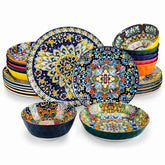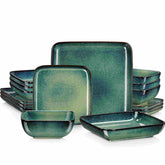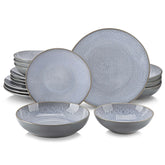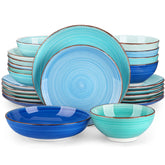Exploring the World of Pasta Bowls: History, Utility, and Captivating Designs
Pasta bowls have become an essential part of our dining experience, offering a dedicated vessel for enjoying the comforting and diverse world of pasta dishes. In this blog post, we will take a deep dive into the fascinating history, versatile utility, and captivating designs of pasta bowls.
I. A Glimpse into the Past: The History of Pasta Bowls
Pasta has been a staple food for centuries, with its origins dating back to ancient civilizations. The concept of pasta bowls can be traced to ancient Rome and China, where wide, shallow bowls were used to serve pasta-like dishes. Over time, pasta bowls evolved in different cultures, adopting unique shapes and sizes that suited regional culinary traditions.
II. Utility and Versatility: Purposeful Design
Pasta bowls are specifically designed to enhance the enjoyment of pasta dishes. Their wide and shallow shape allows for easy tossing and mixing of pasta with sauces, ensuring each strand is coated evenly. The depth of the bowl prevents spillage and facilitates comfortable eating, while the ample capacity accommodates generous portions of pasta, toppings, and sauces.
III. Exploring Design Variations: From Classic to Contemporary
Pasta bowls come in a myriad of designs, reflecting diverse aesthetics and personal preferences. Traditional pasta bowls often feature simple, elegant forms with wide rims, allowing for easy handling and serving. These timeless designs evoke a sense of nostalgia and elegance. In contrast, contemporary pasta bowls showcase a blend of creativity and functionality. Patterns, colors, and textured surfaces add visual interest to the table, making dining experiences more engaging. Some bowls incorporate unique features like built-in strainers or grooves to hold utensils, enhancing convenience and functionality.
IV. Materials: From Earthenware to Porcelain
Pasta bowls are crafted from a range of materials, each offering distinct qualities. Stoneware pasta bowls provide a rustic charm, with their earthy tones and imperfect shapes. Ceramic pasta bowls, on the other hand, offer a refined and delicate aesthetic, often featuring elegant patterns or a smooth, pristine finish. Other popular materials include stoneware, glass, and melamine, each with its own set of advantages in terms of durability, heat retention, and ease of cleaning.
V. Beyond Pasta: Versatile Applications
Although pasta bowls are designed with pasta dishes in mind, their versatility extends far beyond. These bowls are perfect for serving salads, stir-fries, soups, and even desserts. Their wide rims and ample capacity make them suitable for showcasing a variety of culinary creations, adding a touch of sophistication to any meal.
VI. Cultural Significance: Pasta Bowls Around the World
Pasta bowls not only serve a functional purpose but also hold cultural significance in various parts of the world. In Italy, the birthplace of pasta, pasta bowls are an integral part of the Italian dining experience. The wide, shallow shape of pasta bowls allows Italians to mix their pasta with sauces, ensuring an even distribution of flavors. In Asian cultures, such as Japan and China, noodle bowls are used to serve traditional noodle dishes, reflecting the cultural diversity and culinary heritage of the region.
VII. Artisanal Craftsmanship: Handcrafted Pasta Bowls
For those seeking unique and one-of-a-kind pasta bowls, artisanal craftsmanship offers a world of possibilities. Skilled artisans create handcrafted pasta bowls, infusing them with personal touches and artistic flair. These bowls often feature intricate hand-painted designs, textured surfaces, and vibrant colors. By supporting artisanal craftsmanship, you not only bring a piece of art to your dining table but also contribute to the preservation of traditional techniques and cultural heritage.
VIII. Practical Considerations: Choosing the Right Pasta Bowls
When selecting pasta bowls for your collection, there are a few practical considerations to keep in mind. Firstly, consider the size and capacity of the bowl, ensuring it can comfortably accommodate the amount of pasta you typically serve. Additionally, check if the bowls are microwave and dishwasher-safe, as these factors contribute to convenience and ease of use. Finally, consider your style and the overall aesthetic of your kitchen or dining area, selecting bowls that complement your existing tableware and decor.
Conclusion
Pasta bowls are more than just vessels for serving pasta; they embody a rich history, cultural significance, and artistic expression. From their humble beginnings in ancient civilizations to the diverse designs available today, pasta bowls have evolved to meet the needs and preferences of individuals around the world. Whether you opt for classic elegance, contemporary creativity, or artisanal craftsmanship, the right pasta bowl can elevate your dining experience, allowing you to savor the flavors and immerse yourself in the cultural heritage associated with this beloved culinary vessel. So, next time you indulge in a delicious pasta dish, remember to appreciate the pasta bowl that brings both utility and beauty to your table.











